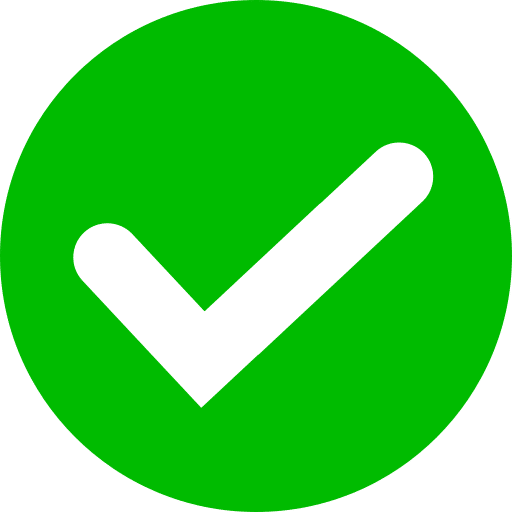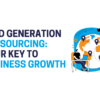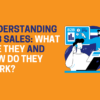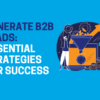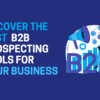Effective sales pipeline management is critical for any business that is looking to maximise and improve its sales potential while driving consistent growth. The ability to attract leads, monitor your sales, and efficiently convert opportunities into customers will hinge on the adoption of best practices in pipeline management.
It doesn’t matter whether you’re a seasoned sales professional or business owner looking to improve your sales strategy, understanding the fundamentals of sales pipeline management and implementing the best practices will be essential for long term success.
Let’s explore the importance of sales pipeline management, best practices for managing the pipeline and the strategies that you can use to improve sales reports.
1. Understanding Pipeline Management in Sales
Sales pipeline management refers to the process of tracking and managing your sales opportunities as they move through various stages of the sales funnel. This will include monitoring the journey of a potential lead from initial contact to final sale and beyond. When a sales pipeline is well structured, it provides visibility into the sales process, which helps businesses to predict future sales and allocate their resources effectively.
Pipeline management involves multiple stages. These stages represent the different phases of a prospect’s journey through the buying process, ranging from initial awareness and interest in the negotiation phase. Ultimately, this leads to closing the deal. By properly managing this pipeline, you can ensure that your sales team focuses their energy on the most promising prospects, which reduces wasted time and increases the likelihood of successful conversions.
Pipeline management goes beyond just tracking leads. You’ll be involved in forecasting revenue and managing relationships, identifying any sales bottlenecks and enhancing the efficiency of the process overall. A business can significantly improve its sales outcomes better when it understands pipeline management.
Learn more about how The Lead Generation Company can help you attract high-quality leads…
2. Sales Pipeline Management Best Practices
There are several best practices that can help to improve efficiency and effectiveness when it comes to managing a sales pipeline. Some of the best practises that you could be adopting include the following:
Define clear stages in the sales pipeline.
These stages will represent the journey the buyer goes on before a sale is completed. They should be clearly outlined so that everybody in the sales team understands the exact point of progression for every lead. The stages will typically include:
- Lead generation – when the lead is first identified.
- Qualifying the lead – determining if they fit your ideal customer profile.
- Proposal – when you’re engaging with the lead to move them closer to a deal.
- Closing – finalising the sale.
Stages must be well defined to offer clarity on where leads are in the sales process so that no opportunities are overlooked.
Implement lead scoring.
No two leads are created equal, with some more likely to convert than others. Lead scoring is a technique that could help the sales team to prioritise which leads will be likely to convert. By assigning a score to each lead, based on factors like demographic information and behaviour, businesses are able to ensure that salespeople focus on the most promising opportunities available to them.
Lead scoring can also help in pipeline management by preventing sales teams from wasting time on unqualified leads. Resources can be allocated more effectively and ensure that efforts are directed towards high value prospects.
Use a customer relationship management system for better tracking.
If you want to manage a sales pipeline effectively, you need the right software. CRM systems can centralised all sales related information which allows sales teams to track leads and record their interactions with them. You’ll also be able to use it for forecasting, identifying trends, and generating sales reports. These are invaluable for making informed decisions. A centralised system can help businesses to avoid inefficiencies such as duplication of efforts or the loss of vital information. Explore leading CRM systems likes Salesforce to streamline your sales process.
Review and update your pipeline regularly.
Pipeline management in a sales team is not a one off task. With regular reviews and updates, you’ll be able to see any opportunities that can change. You’ll be able to identify any bottlenecks, any areas of improvement, and opportunities for upselling or cross selling with your team. Setting aside time for weekly or monthly pipeline reviews is important, as you’ll be able to assess the status of each opportunity, update the progress and reprioritise your leads.
Establish clear communication.
Sales pipeline management is not isolated to an individual salesperson. It’s a collaborative effort between team members and managers as well as other stakeholders. With clear communication and regular collaboration between all sales teams and management, you’ll have pipeline success. Insights and challenges must be shared from the teams to the management and back again, and you should incorporate customer feedback in there to refine your approach.
3. Steps to Effectively Manage a Sales Pipeline
There are several steps that businesses can take to manage their sales pipeline effectively, and these include:
Tracking key metrics.
Sales pipeline management is not just about tracking leads, but monitoring key performance indicators that can include the number of opportunities at each stage, the conversion rate from one stage to the next, and the average deal size. When you track these metrics, you can better understand the health of your pipeline and forecast future sales with a lot more accuracy.
Optimising sales processes.
Your business should focus on optimising their sales processes, which include streamlining workflows and automating routine tasks. When you do this, you can reduce any unnecessary steps that could slow down the process in general. Automation tools, such as email sequences or follow up reminders, can help to maintain momentum in the pipeline to ensure that no opportunity is left behind.
Nurture those leads.
Nurturing leads is an important part of pipeline management. At every stage of the pipeline, the sales team should be actively engaging with prospects and providing valuable content, answering questions and addressing concerns. The goal here is to build relationships and move leads closer to making a purchasing decision, and effectively nurturing can help.
4. How to Excellently Manage Your Sales Pipeline
To excel at sales pipeline management, it’s important to implement best practices along the way in both the short and long term. The following strategies can help:
Work to adopt a data driven approach.
One of the most powerful tools in pipeline management is data and by using data analytics to monitor customer behaviour and track conversion rates, your business can gain valuable insights into what’s working and what isn’t. If you’re looking to refine strategies and improve forecasting accuracy, taking a data driven approach can really help to maximise those conversion rates.
Communicate clear sales goals.
With clear and measurable sales goals, you’ll be able to focus your efforts and drive consistent results. It doesn’t matter what the goal is, having specific and measurable targets can give your sales team direction and purpose.
Stay agile.
Sales pipeline management is not one size fits all. Every industry, business, and market has unique characteristics which means that it’s important to remain agile and adapt the pipeline to meet the changing needs of your business. It’s one of the reasons that you have to regularly assess your pipeline and make adjustments so that you can improve performance and better cater to your target market.
5. Sales Funnel Management Best Practices
Sales funnel management is a subset of sales pipeline management. The funnel refers to the stages that a lead passes through, which we talked about earlier, from their awareness to decision making. To manage your sales funnel, the best practises include:
Segmenting the funnel.
Not every lead will be at the same point in the buyer journey. By segmenting your funnel, you’ll be able to tell your messaging and your approach to different stages, which improves the chances of converting a customer.
Stay at the top.
By focusing on lead generation at the top of the funnel, you’ll be able to build a much stronger pipeline. You can focus on generating high quality leads at the top to feed the rest of the pipeline on the way down.
Nurture your engaged leads.
Continuously engaging with leads throughout the journey by providing relevant content and following up with personal communication can help them move down the funnel.
6. Sales Pipeline Stages: Best Practices to Adopt
The sales pipeline is divided into distinct stages and each stage requires tailored strategies to optimise the chances of a conversion. Let’s take a look at each stage below.
Top of the funnel lead generation.
The very first stage of the sales pipeline is all about attracting leads. This is where you generate awareness of your product, brand, or service among your target audience. The aim here is to capture the attention of those who may benefit from your solution but not yet familiar with your company.
You can do this through content marketing, SCO and SEM, social media engagement, referrals, and lead magnets. You can create and engage people in valuable content that resonates with their pain points. You could optimise your website and content for search engines to ensure that your business appears where people are looking for solutions. You can leverage online social media platforms to connect with prospects and encourage existing clients to refer to people they know who might benefit from your product or service. With free resources on your website such as ebooks, white papers, or free trials to entice visitors, you’ll be able to build a database of leads who could be natural through subsequent stages.
It’s all about building a solid foundation of qualified leads that can move through the rest of the sales pipeline.
Early funnel lead qualification stage.
When you have established a list of potential leads, the next step that you have to take is to qualify them. Not all leads will be suitable for your business, so you can assign numerical scores to your leads based on various factors such as engagement level, industry, company size, and purchasing.
You could use qualified established frameworks such as BANT (Budget, Authority, Need, Timeline) to assess whether the lead fits your customer profile. Even if a lead is not ready to convert straight away, it doesn’t mean that they should be discarded. You can use content marketing or email drip campaigns to nurture the lead until they’re ready.
This stage is all about building the important rapport with all of the prospects that the sales agent is working with.
Middle of the funnel proposal and negotiation.
It’s now time to present your solution and begin the negotiation process, and it’s here that prospects are evaluating whether what you’re offering fits their needs. You can take your proposal to the specific needs and requirements for the individual lead because a one size fits all approach to proposal will not be compelling.
You can then emphasise the value that your product or service provides, demonstrating clear return on investment so that you can show the prospect why investing in your solution will benefit them. During any negotiations, you can make sure to actively listen to the prospects’ concerns. From here, you can offer flexibility in your payment terms or discounts, and then follow up on this stage regularly. This is often where deals can go cold if they’re not nurtured correctly.
Bottom of the funnel closing the deal.
This is the final stage of the sales pipeline where all of your efforts culminate in converting the lead into a customer. You can use time limited offers or highlight potential consequences of delaying a decision to create urgency.
If you make the closing process as simple as possible, you’ll be able to keep that lead nurtured and excited about finishing the deal rather than going cold. When all is finalised, celebrate the success with your team. It’s a good morale booster and it helps to foster a sense of achievement.
Beyond the pipeline post sales follow up.
When the deal is closed, engagement with the customer doesn’t have to end there. Maintaining a strong relationship is how you gain customer loyalty, repeat businesses and referrals. Offering a seamless onboarding experience for customers ensures that they are prepared to use their product or service.
When you check in regularly, ensuring that their needs are being met, you’ll be able to address any potential issues. You can then encourage feedback on both the sales process and the product or service itself which can offer valuable insights. Read more about Sales Pipeline Stages.
7. Improving Your Sales Pipeline Management Reporting
Effective pipeline reporting is essential for tracking performance and making the correct decisions. If you want to optimise the sales process, you need to improve the sales pipeline management reporting, and for this you can start by establishing key performance indicators such as lead conversion rate, sales velocity, win rates, and average deal sizes.
These are the metrics that provide valuable insights into the efficiency of your pipeline along the way. Many modern customer relationship management systems offer customizable dashboards and reporting features and using these can help you decentralise your pipeline data and generate real-time reports. With regular pipeline reviews, you’ll be able to identify any issues earlier and adjust your strategies accordingly.
With accurate sales forecasting, you’ll be able to analyse historical data. It’s with this information that you can predict the likelihood of closing any deals and estimate future revenue. By continuously updating forecasts based on the latest data, you’ll be able to improve accuracy and prevent revenue slumps. All of these reports should be shared across departments so that you can ensure transparency and a collaborative approach within your team.
Lastly, focus on continuous improvement by using pipeline data to optimise the sales process. You could help to refine qualification criteria and enhance training among your team. You may also want to automate manual tasks to improve efficiency. See Sales Forecasting Techniques.
8. Achieving Success: Sales Pipeline Best Practices
To gain success in pipeline management, you need a structured approach, regular reviews, and constant refinement. Effective sales pipeline management is important for your business if you’re looking to scale, grow revenue, and improve your conversion rates. If you want to achieve success, some of the steps that you can take include:
Optimise your sales process.
Sales pipeline management is not static and as customer expectations and market conditions evolve, you have to continuously assess and optimise your pipeline process. This includes refining a qualification criteria and automating repetitive tasks.
Invest in a well trained sales team.
There will not be a pipeline to manage if you don’t have a sales team at the helm. Regular trading on product knowledge, sales techniques, and systems will ensure that your team can perform at their best. By investing in training and development and providing ongoing support, you can help your team to overcome any challenges and remain motivated through the sales process. Read this Forbes article on the importance of Sales Training.
Use technology where you can.
Automating and streamlining sales pipeline management is easier when you embrace technology. Marketing automation software and analytics platforms can significantly improve your efficiency while reducing manual errors.
It should be a team effort.
With a culture of collaboration between sales, marketing and customer success teams, you’ll have a smooth transition of leads through the pipeline. Cross functional collaboration is a must if you want success.
Build those customer relationships.
In the end, it’s not just about closing deals. You need to build lasting relationships with your customers and focus on providing value while being responsive and offering exceptional customer service. Satisfied customers will always come back, but they are also more likely to refer others, feeding future pipeline growth.
Effective sales pipeline management is more than just a buzzword, it’s a crucial driver of sustainable business growth. From lead generation to deal closure and beyond, every stage of the pipeline needs careful planning, consistent monitoring, and a strategic approach. By implementing the best practices outlined above, such as lead scoring, regular pipeline reviews, and data-driven decision making—you can significantly boost conversion rates, shorten sales cycles, and empower your team to focus on what matters most: closing high-quality deals.
At The Lead Generation Company, we understand the power of a well-managed sales pipeline. Our expert team is dedicated to helping B2B businesses like yours attract, qualify, and convert leads through proven outbound strategies. Whether you’re looking to build your pipeline from the ground up or refine your existing approach, we’re here to help.
Ready to supercharge your sales pipeline?
Get in touch with The Lead Generation Company today to learn how our lead generation solutions can drive measurable results for your business.

Ryan Whyte is a Director of The Lead Generation Company where he leads a team of B2B telemarketers to deliver high-quality leads for clients. With a strong background in campaign management and a focus on driving results, Ryan is dedicated to optimising strategies that maximise client success in B2B lead generation.




